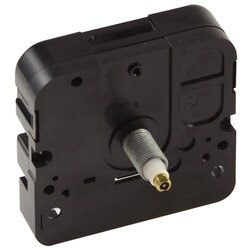Don't wanna be here? Send us removal request.
Text
Just How Clock Movements and Motors Operate

Clock movements and also motors are the significances, the engines, of watches. Clock movements and motors could be electronic or analog, electronic or mechanical, yet their main purpose is to position each hand at the right subtended angle moment by minute. These curious gadgets have existed for centuries in numerous types, as well as they mirror a rich history. clock parts
Clock electric motors as well as movements are identical from each other in their meaning, though the term "movement" has a tendency to be preferred by the profession, while "electric motor" appeals to the layperson. Until reasonably recently they were mechanical in their operation, with a pressure of coiled springs or hanging weights applying torque to a flywheel. The resulting turning was exchanged an oscillation at a specific frequency by aid of pendulums and also escapements.
The contemporary engines are not mechanical, however digital. The energy resource is a quartz crystal, which, with voltage put on it, discharges pulse trains at its quick reverberating regularity. The pulses are counted as well as accumulated into numerical registers, and also subdividing the counts yields the matching of running seconds, minutes, and hrs.
This equivalent is really a quantity of turning-- really a collected rotation-- for every hand. The old mechanical method used a network of equipments to accomplish short-lived hand setting as well as a differential according to every tick of the pendulum. The digital method makes use of math to determine short-lived setting from the register worths.
These are the basics of timekeeping utilizing an analog display screen of dial plus hands. But don't forget that timekeeping is routine, indicating that the display screen is intermittent as well as everything at some point resets to absolutely no, as it were. One of the most usual period is twelve hrs (noon looks the same as midnight), but greater durations are feasible as well as occasionally utilized.
An evident expansion is the 24-hour duration, however there is absolutely nothing to prevent the regular or month-to-month duration being set, as well as also much longer ones are certainly possible. The clock motion just needs to be set up accordingly. Mechanically this calls for entirely sprucing up the gear network, but electronically it is simply a matter of programs-- a lot easier task.
Time expansions usually call for an added hand (e.g., to point at the day of the week or the date in the month). A lot more difficult motors can track lunar cycles and also reveal trend level. As a result of its periodicity (though out of sync with the solar cycle), it is straightforward to integrate tide-level display with normal timekeeping.
Movements can also be coopted, in a sense, to reveal different climate sensations. The dial is altered to reveal a range of worths around the circumference, and a solitary hand actions within that array. The habits is not intermittent (temperature level, pressure, as well as humidity differ somewhat arbitrarily between extremes), so sensors determine values moment by minute, and also the worths are converted into hand position.
Modern electronic clock movements are well equipped to capitalize on software program abilities to provide substantial selections of functions, almost restricted just by the creative imagination. Some of these functions are novelties comparable to those located in heirloom wrist watches, such as chimes and oscillating pendulums (which are no longer practical however totally cosmetic). Net suppliers have vast options of components to choose from.
One point the viewers must understand is that makers style clock electric motors to work over a wide variety of sizes, dealing with the fat part of the marketplace. The dials, hands, instances, etc, can be acquired separately but pair up in regards to size as well as style. However, when sizes of timepieces get over 12 to 14 inches, the longer and also larger minute hands obtain more difficult and also more challenging to turn effectively.
Now the one-design-fits-all method breaks down, yet the distributor must have offered a functionally similar motor with beefed-up torque. In a similar way, take into consideration the different sizes of battery made use of to power clocks (usually AA or C) as well as pick what works best for your requirements.
Whether as a hobbyist or as a professional, clockmaking from components can be satisfying and satisfying. Success stops by understanding exactly how clock movements and electric motors operate.
youtube
1 note
·
View note